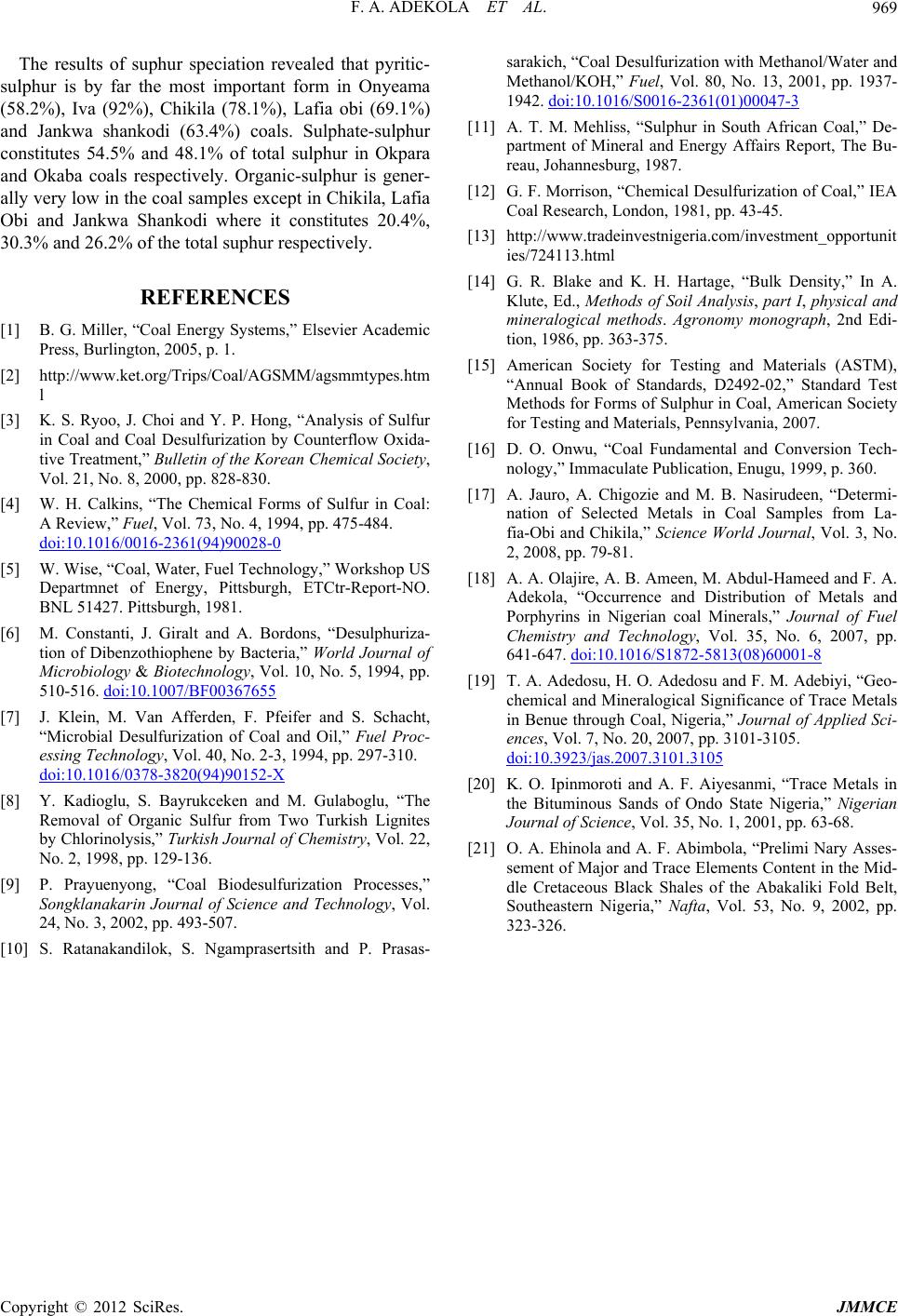
F. A. ADEKOLA ET AL. 969
The results of suphur speciation revealed that pyritic-
sulphur is by far the most important form in Onyeama
(58.2%), Iva (92%), Chikila (78.1%), Lafia obi (69.1%)
and Jankwa shankodi (63.4%) coals. Sulphate-sulphur
constitutes 54.5% and 48.1% of total sulphur in Okpara
and Okaba coals respectively. Organic-sulphur is gener-
ally very low in the coal samples except in Chik ila, Lafia
Obi and Jankwa Shankodi where it constitutes 20.4%,
30.3% and 26.2% of the total suphur respectively.
REFERENCES
[1] B. G. Miller, “Coal Energy Systems,” Elsevier Academic
Press, Burlington, 2005, p. 1.
[2] http://www.ket.org/Trips/Coal/AGSMM/agsmmtypes.htm
l
[3] K. S. Ryoo, J. Choi and Y. P. Hong, “Analysis of Sulfur
in Coal and Coal Desulfurization by Counterflow Oxida-
tive Trea tment, ” Bulletin of the Korean Chemical Society,
Vol. 21, No. 8, 2000, pp. 828-830.
[4] W. H. Calkins, “The Chemical Forms of Sulfur in Coal:
A Review,” Fuel, Vol. 73, No. 4, 1994, pp. 475-484.
doi:10.1016/0016-2361(94)90028-0
[5] W. Wise, “Coal, Water, Fuel Technology,” Workshop US
Departmnet of Energy, Pittsburgh, ETCtr-Report-NO.
BNL 51427. Pittsburgh, 1981.
[6] M. Constanti, J. Giralt and A. Bordons, “Desulphuriza-
tion of Dibenzothiophene by Bacteria,” World Journal of
Microbiology & Biotechnology, Vol. 10, No. 5, 1994, pp.
510-516. doi:10.1007/BF00367655
[7] J. Klein, M. Van Afferden, F. Pfeifer and S. Schacht,
“Microbial Desulfurization of Coal and Oil,” Fuel Proc-
essing Technology, Vol. 40, No. 2-3, 1994, pp. 297-310.
doi:10.1016/0378-3820(94)90152-X
[8] Y. Kadioglu, S. Bayrukceken and M. Gulaboglu, “The
Removal of Organic Sulfur from Two Turkish Lignites
by Chlorinolysis,” Turkish Journal of Chemistry, Vol. 22,
No. 2, 1998, pp. 129-136.
[9] P. Prayuenyong, “Coal Biodesulfurization Processes,”
Songklanakarin Journal of Science and Technology, Vol.
24, No. 3, 2002, pp. 493-507.
[10] S. Ratanakandilok, S. Ngamprasertsith and P. Prasas-
sarakich, “Coal Desulfurization with Methanol/Water and
Methanol/KOH,” Fuel, Vol. 80, No. 13, 2001, pp. 1937-
1942. doi:10.1016/S0016-2361(01)00047-3
[11] A. T. M. Mehliss, “Sulphur in South African Coal,” De-
partment of Mineral and Energy Affairs Report, The Bu-
reau, Johannesburg, 1987.
[12] G. F. Morrison, “Chemical Desulfurization of Coal,” IEA
Coal Research, London, 1981, pp. 43-45.
[13] http://www.tradeinvestnigeria.com/investment_opportunit
ies/724113.html
[14] G. R. Blake and K. H. Hartage, “Bulk Density,” In A.
Klute, Ed., Methods of Soil Analysis, part I, physical and
mineralogical methods. Agronomy monograph, 2nd Edi-
tion, 1986, pp. 363-375.
[15] American Society for Testing and Materials (ASTM),
“Annual Book of Standards, D2492-02,” Standard Test
Methods for Forms of Sulphur in Coal, American Society
for Testing an d Materials, Pennsylvania, 2007.
[16] D. O. Onwu, “Coal Fundamental and Conversion Tech-
nology,” Immaculate Publication, Enugu, 1999, p. 360.
[17] A. Jauro, A. Chigozie and M. B. Nasirudeen, “Determi-
nation of Selected Metals in Coal Samples from La-
fia-Obi and Chikila,” Science World Journal, Vol. 3, No.
2, 2008, pp. 79-81.
[18] A. A. Olajire, A. B. Ameen, M. Abdul-Hameed and F. A.
Adekola, “Occurrence and Distribution of Metals and
Porphyrins in Nigerian coal Minerals,” Journal of Fuel
Chemistry and Technology, Vol. 35, No. 6, 2007, pp.
641-647. doi:10.1016/S1872-5813(08)60001-8
[19] T. A. Adedosu, H. O. Adedosu and F. M. Adebiyi, “Geo-
chemical and Mineralogical Significance of Trace Metals
in Benue through Coal, Nigeria,” Journal of Applied Sci-
ences, Vol. 7, No. 20, 2007, pp. 3101-3105.
doi:10.3923/jas.2007.3101.3105
[20] K. O. Ipinmoroti and A. F. Aiyesanmi, “Trace Metals in
the Bituminous Sands of Ondo State Nigeria,” Nigerian
Journal of Science, Vol. 35, No. 1, 2001, pp. 63-68.
[21] O. A. Ehinola and A. F. Abimbola, “Prelimi Nary Asses-
sement of Major and Trace Elements Content in the Mid-
dle Cretaceous Black Shales of the Abakaliki Fold Belt,
Southeastern Nigeria,” Nafta, Vol. 53, No. 9, 2002, pp.
323-326.
Copyright © 2012 SciRes. JMMCE